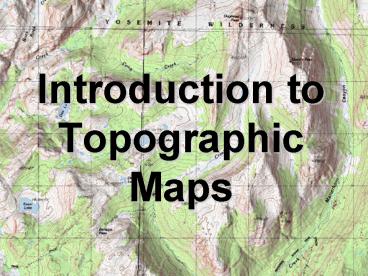Introduction to Topographic Maps - PowerPoint PPT Presentation
1 / 32
Title:
Introduction to Topographic Maps
Description:
Introduction to Topographic Maps Topographic Maps Two dimensional model of the Earth s surface (represents 3-D world) Topographic maps are also known as contour maps. – PowerPoint PPT presentation
Number of Views:751
Avg rating:3.0/5.0
Title: Introduction to Topographic Maps
1
Introduction to Topographic Maps
2
Topographic Maps
- Two dimensional model of the Earths surface
(represents 3-D world) - Topographic maps are also known as contour maps.
- Show elevation above sea level using contour
lines.
3
(No Transcript)
4
(No Transcript)
5
(No Transcript)
6
Real World
Contour Map
7
Topographic Maps
- Contour Line
- - line on a map that connects points of EQUAL
elevation. - - show elevation and shape of the land
- Relief Difference between high and low
elevations
8
(No Transcript)
9
Topographic Maps
- Contour Interval
- difference in elevation between each line. MUST
be equal spacing. - Contour interval
- 20 feet
580
560
540
520
10
Topographic Maps
- Index Contour
- Usually every 5th line is printed darker and has
an elevation printed on it.
11
(No Transcript)
12
Rules for Contours
- Contour lines never cross
13
Rules for Contours
- 2. Contours form closed loops (even if not shown
of the map.
14
Rules for Contours
- 3. Contours bend upstream (uphill) when crossing
a stream.
15
(No Transcript)
16
Rules for Contours
- The maximum possible elevation for a hill is 1
less than what the next contour should be. - The highest possible elevation of the hill is
just below the value of the next line that is
not shown
90
80
70
60
50
17
399
179
239
18
Closely Spaced Contours
- Steeper Slope (Gradient) contour lines are
closer together.
19
(No Transcript)
20
Wide Spaced Contours
- Gradual/Gentle Slope (Gradient) contour lines
are farther apart.
21
(No Transcript)
22
A
B
23
Depressions
- Contour lines which show a depression, crater, or
sinkhole on a map. - Shown by dashed lines (hachure marks) on the
inside of a contour line - The elevation of the first depression contour is
the same as the lowest regular contour near it.
24
Rules for Contours
- The lowest possible elevation for a depression
is 1 more than what the next contour should
be. - The lowest possible elevation of a depression is
just above the value of the next line that is
not shown
90
90
51
80
70
60
50
25
100
100
50
26
Benchmarks
- a location whose exact elevation is known and is
noted on a brass or aluminum plate. - bench marks are shown on maps by an X with the
letters BM written next to them.
27
(No Transcript)
28
Map Scales
- Indicates the distance on the map compared to
distance in the real world - Graphical - by a line divided into equal parts
and marked in units of length.
29
Map Scales
- Numerically usually by writing a fraction to
show what part of the true distances map
distances really are. - 163,360
- One inch on the map equals 63,360 Inches in the
real world. - (There are 63,360 inches in a mile)
30
Gradient
- The slope between any two points on a hill
- Gradient
Change in Field Value Distance
31
Gradient
- A trail is four miles long as measured by the
scale on a map. The beginning of the trail is at
the 1,060 ft contour line and the end of the
trail is at the 960 ft contour line. Calculate
the gradient of the trail. - Gradient
1060 ft 960 ft 4 miles
25.0 ft/mi
32
Gradient
Contour Interval 20 ft
200
0
2
4
6
8
10
miles































